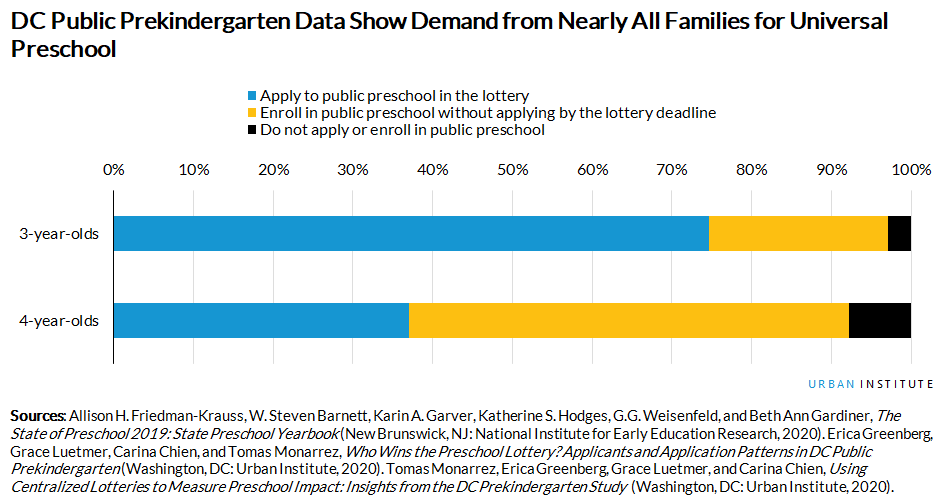
<p>FatCamera / Getty Images</p>
The American Families Plan includes a historic investment in young children and public education in its proposal to offer preschool to all 3- and 4-year-olds. The plan cites rigorous research on the benefits of universal preschool and the importance of broad access, especially for children of color and children from families with low incomes. But truly universal preschool may require an even larger investment.
Data from the District of Columbia show that a universal program where every family that wanted a seat could enroll would have to be substantially larger than the one proposed by the Biden-Harris administration. Application and enrollment patterns from DC suggest up to 97 percent of families with young children may seek to participate in a nationwide universal program. If the Biden-Harris administration aims to serve all 3- and 4-year-olds whose families want to enroll, they will have to plan on a scale never before seen in the US.
A plan to serve 80 percent of children
The American Families Plan would serve about 5 million children through $200 billion in national-state partnerships. This investment would supplement existing state and local investments in preschool. Before the pandemic decimated preschool enrollment, states served more than 1.6 million children with $9 billion. Existing programs lean toward enrolling older children, reaching 34 percent of 4-year-olds and 6 percent of 3-year-olds nationwide. Several cities and counties have also begun providing preschool.
Adding about 5 million new seats for public preschool would bring total national enrollment to 6.6 million children—just over 80 percent of an estimated 8.2 million 3- and 4-year-olds. Local programs (the largest of which, in New York City, serves about 70,000 children) would add additional capacity. An investment of this size would bring the national enrollment rate up to that of the largest public preschool programs to date. But even serving 85 percent of children doesn’t amount to universal.
How many is universal?
I estimate demand for universal preschool using data from the District of Columbia prekindergarten program, which ranks first in access (PDF) for 3-year-olds and 4-year-olds. Our team is leading a study of DC prekindergarten based around a centralized admissions lottery. Families apply to the lottery by ranking their preferred schools and are matched with seats based on their rankings, schools’ capacity, and lottery draws. Families are also able to apply directly to DC prekindergarten’s community-based preschool classrooms included in the mixed delivery system. Together, application and enrollment patterns demonstrate the demand for universal preschool.
In 2018, I estimate 75 percent of 3-year-olds applied for public preschool in the lottery, making 3-year-old preschool the entry grade for public education in DC. Many 3-year-olds who enroll stay on in the same school, so they are not required to apply for the 4-year-old year. Still, 37 percent of 4-year-olds applied for public preschool in 2018.
In addition, 22 percent of 3-year-olds and 55 percent of 4-year-olds enrolled in DC prekindergarten without applying by the lottery deadline. Families of 3-year-olds might have applied in the post-lottery and enrolled in schools with open seats, or they might have applied directly to community-based programs that offer DC prekindergarten but do not participate in the lottery. Families of 4-year-olds could have taken either of those paths, or they could have remained in the schools where they enrolled their children the year before.

Combining lottery applicants and children who enrolled without applying by the lottery deadline, these estimates suggest that nearly all families with 3-year-olds (97 percent) and 4-year-olds (92 percent) would enroll in a “free, high-quality, accessible, and inclusive” universal preschool program, like the one proposed in the American Families Plan. A plan to serve 80 percent of children will likely fall short of demand.
Toward universal preschool
DC public prekindergarten is a national model, but it might not be a perfect barometer for national interest in public preschool. DC is urban, with many walkable communities and a public transportation system to support access. It has unusually high maternal labor force participation rates. The idea of preschool expansion has been controversial in states like Idaho, though popular in states like Oklahoma. The politics of preschool have long been complicated. But so were the politics of primary school when states like Massachusetts began democratizing education.
Against this backdrop, the American Families Plan seeks to build a new tradition in American education. If it succeeds at the level of DC prekindergarten, it may grow to serve nearly 7.8 million 3- and 4-year-olds with $311 billion. That’s universal.
The Urban Institute has the evidence to show what it will take to create a society where everyone has a fair shot at achieving their vision of success.
Let’s build a future where everyone, everywhere has the opportunity and power to thrive
Urban is more determined than ever to partner with changemakers to unlock opportunities that give people across the country a fair shot at reaching their fullest potential. Invest in Urban to power this type of work.